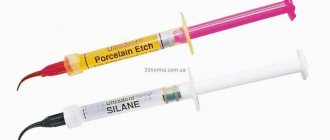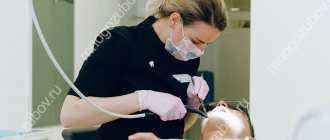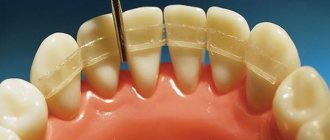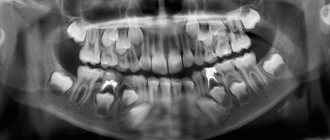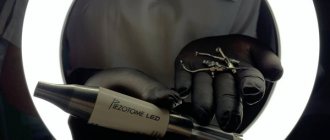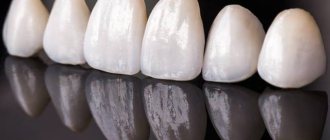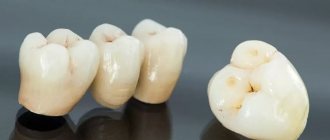Electrophoresis in dentistry is a physiotherapeutic procedure when medicinal substances are introduced into the body through electric current. This method uses special compounds that, under the influence of electricity, disintegrate into ions, accumulate in the pathological area and have a targeted effect on it. Thus, maximum therapeutic effect is achieved.
Indications for the use of electrophoresis in dentistry
- periodontitis;
- pulpitis;
- glossalgia;
- glossitis;
- purulent and inflammatory diseases of the oral cavity;
- dental cysts;
- dental granulomas;
- pathology of the facial nerve;
- inflammation of dental cells (alveolitis);
- lesions of the oral mucosa;
- severe pain after treatment or tooth extraction.
Despite the rapid development of technology in dentistry, electrophoresis has been and remains one of the most effective and affordable physiotherapeutic methods for treating hard and soft dental tissues.
Contraindications to the use of electrophoresis
Like any other method of physiotherapy or drug, electrophoresis has its own contraindications that you need to be aware of:
- presence of a pacemaker;
- heart failure;
- tumors;
- heat;
- various inflammations at the acute stage;
- poor blood clotting (pathology, menstruation is a natural process and is not a limitation);
- severe form of bronchial asthma;
- skin diseases such as dermatitis;
- cuts, wounds or other damage in the area where the electrodes are applied;
- allergy to medication and intolerance to electrical procedures.
Side effects are rare, but they do exist. This may include redness, itching, or swelling at the electrode site if you are allergic to a medication or have a reaction to electrical current. At the 2-3 session, there may be an increase in temperature and pain due to inflammatory diseases, but after the end of the course they disappear on their own.
Features of electrophoresis for teeth
The procedure is performed in a treatment room and is comfortable and painless. Allows you to quickly relieve pain in the tissues, inside the dental canal, thereby eliminating foci of infection. Medicines are administered slowly, and the therapeutic effect lasts for several weeks. The risk of developing allergic reactions is minimal.
Medicines used in electrophoresis:
- lidocaine;
- iodine;
- vitamin cocktails;
- calcium;
- a nicotinic acid;
- novocaine, etc.
Purified water, dimexide, and buffer compounds are used as solvents.
Drug electrophoresis in dentistry is performed as follows:
- a special pad is wetted in the medicinal composition;
- the element is fixed at the site of inflammation;
- when treating pulpitis, the teeth are pre-treated and the drug is simultaneously injected into the canals;
- the tissues of the oral cavity are exposed to weak current pulses through the pad;
- The patient is given an electric current with a gradual increase in strength until painful sensations appear. Thus, the optimal indicator of the power of impact on the zone is determined;
- the procedure lasts about 10 – 30 minutes.
The average duration of an electrophoresis course is 10-20 procedures, which are performed daily or with breaks of one or two days.
Types of electrophoresis
- Galvanic electrophoresis . The current is supplied continuously, one of the positive “+” electrodes is placed on the diseased area, the other electrode with a negative “-” electrode is placed according to the diagrams indicated in the operating manual for the device;
- Bath electrophoresis . The electrodes are placed in a bath with a healing solution. The patient lowers the injured part of the body into the liquid. This method is suitable only if the limb is damaged.
- Cavity electrophoresis . One of the electrodes is placed in a hollow organ such as the stomach, uterus, bladder or intestines; a medicinal solution is administered. The other electrode is located on the surface of the body.
- Interstitial electrophoresis . The solution is administered by injection or by mouth, after which electrodes are placed in the area of inflammation.
Sometimes electrophoresis is called iontophoresis, but this is not entirely true: yes, both procedures work on galvanic current, however, it’s all about its quantity. With iontophoresis, the discharge is very weak and constant, while electrophoresis involves its increase during the session.
The differences don't end there. In iontophoresis, two oppositely charged electrodes are placed next to each other in a pad soaked in a physical solution. With galvanic electrophoresis, one electrode is placed on the problem area of the patient’s body, and the person holds the oppositely charged electrode in his hand (or the electrode is fixed on the body, depending on the type of procedure).
Next, we will cover in more detail the method of galvanic electrophoresis, since it is this method that is most often used both in medicine and in cosmetology.
Methodology and mechanism of dental electrophoresis
This therapeutic method has a number of advantages over others. These include:
- There are no general negative effects of drugs on the body. The main effect is local, there is no systemic effect, the drugs do not pass through the liver, and therefore it is possible to achieve the desired effect with minimal side effects.
- The combined local effect of electric current (which also has a beneficial effect) and medications.
- The ability to administer the drug (depending on the doctor’s decision) to a place where it is difficult to deliver it by other methods.
Nasal electrophoresis with calcium
In the nasal area, electrophoresis is used to treat otolaryngological diseases, lung diseases, and dental pathologies. Electrophoresis acts locally and systemically, and its effect contributes to:
- reducing the inflammatory process;
- reducing swelling;
- accelerating regeneration processes;
- activation of the body's defense mechanisms.
Most often, electrophoresis with calcium in the nose is prescribed for:
- inflammation in the nasal cavity and sinuses (sinusitis, rhinitis, etc.);
- inflammation in the ears (otitis media);
- dental diseases (pulpitis, granulomas, etc.);
- lung diseases (bronchitis, pneumonia).
Before electrophoresis is carried out in the nose, the nasal sinuses are washed with water to free them from mucous masses and contamination. Next, special tampons are moistened with a calcium-containing preparation and placed into the nose to a depth of 1-2 cm. An electrode with two plates is placed in both nostrils, and the other in the area of the lower cervical vertebrae. During the procedure, the drug is well absorbed through the nasal mucosa and penetrates the nasal sinuses.
Electrophoresis with calcium: contraindications
Contraindications for the procedure include:
- increased sensitivity and individual intolerance to drugs containing calcium;
- electric shock intolerance;
- the presence of purulent foci of inflammation;
- damage to the skin;
- dermatitis;
- body temperature above subfebrile levels;
- oncological diseases;
- presence of a pacemaker;
- severe disruption of the cardiovascular system;
- severe impairment of the kidneys and liver;
- mental disorders.
Intrachannel electrophoresis
Intracanal electrophoresis is widely used in the treatment of pulpitis. For this procedure, the doctor thoroughly cleans the tooth canals, first only mechanically, and then with alcohol, ether or hydrogen peroxide. A swab is placed in the mouth and the tip of the wire (active electrode) is inserted. To prevent saliva from entering the tooth cavity, the wire and tooth are covered with sticky wax.
A passive electrode is attached to the forearm of one hand. At the end of the procedure, the wax, sponge and electrode are removed, and the dentist fills the dressing with artificial dentin and leaves a sponge soaked in a mixture of disinfectants underneath. Such procedures are carried out in a course, every day or every other day.
Dental surgeons often use intracanal iodine electrophoresis to treat pulpitis. The use of this technique completes the cleaning of micro- and macro-channels, destroys all bacteria and mummifies the remaining pulp.
However, transchannel electrophoresis has several unpleasant features:
- The doctor does this at an iodine concentration of about 10%.
- During the procedure, the current strength increases.
- A session of transscale electrophoresis usually lasts at least 30 minutes.
Therefore, transchannel electrophoresis is an unpleasant procedure and can be painful.
In addition to iodine electrophoresis, other ions are used in dental practice: calcium, copper, zinc, etc. All of them reduce pain, have anti-inflammatory properties and stimulate the body's regenerative processes.
There is also the so-called drug-free (hydroxyl) iontophoresis, when the electrolyte is the liquid in the root canal.
Material and methods
The study involved 91 patients aged 18 to 65 years. All patients signed informed consent to conduct research. Treatment and examination were carried out in 91 teeth, of which in 48 (53%) teeth there were no periapical changes, and in 43 (47%) destructive changes in the periodontium were noted.
To determine the antimicrobial effect of various types of direct current exposure in vitro
used clinical strains of facultative anaerobic bacteria obtained from the root canals of teeth, namely:
Staphilococcus epidermidis
,
Streptococcus sanguis
,
Streptococcus mutans
,
Streptococcus salivarius
,
Candida krusei
,
Escherichia coli
,
Clostridium
spp.
For the cultivation of staphylococcus, streptococci and clostridia, 5% blood agar was used, E. coli - meat-peptone agar, and for Candida krusei
- Sabouraud's medium.
The study was carried out as follows: microbial cultures were inoculated onto the surface of freshly prepared agar in Petri dishes at a concentration of 1 million cells/ml (according to the optical turbidity standard) using the “lawn” method, evenly distributing them over the surface of the agar using a sterile spatula. Then the Petri dish was divided into sectors. In each sector, the antibacterial effect on a certain type of microorganism of a separate type of exposure to direct current was studied [7].
When studying apex phoresis, the active section of a silver-copper electrode connected to the positive pole of a current source was placed in the sector.
For anode galvanization, a single-core copper electrode was used, the active section of which was wrapped in a cotton swab with a diameter of 5 mm moistened with water. The electrode was connected to the positive pole of the current source.
When studying iodine electrophoresis, a single-core copper electrode was also placed in the sector, the active section of which was wrapped in a cotton ball with a diameter of 5 mm, moistened with a 10% solution of potassium iodide or a 10% solution of potassium iodide with the addition of 5% tincture of iodine, while the electrode was connected to the negative pole of the current source .
During depophoresis of copper-calcium hydroxide, a portion of copper-calcium hydroxide with a diameter of 5 mm was placed in the sector, in the center of which a metal electrode was placed, connected to the negative pole of the current source.
The exposure dose for apex phoresis was 5 mA x min, iodine electrophoresis and anode galvanization was 20 mA x min, and for depophoresis it was 5 mA x min.
During the study, one of the sectors served as a control. A test sample of an electrode or an electrode with a medicinal substance was placed in it, but the electrode itself was not connected to a current source (the action of passive diffusion).
After completing the procedure, the Petri dishes were placed in anaerostats with an oxygen-free gas mixture containing 80% nitrogen, 10% hydrogen, 10% carbon dioxide. The results were recorded after 7 days of incubation of Petri dishes in an anaerostat at 37 °C. The count was carried out by measuring the diameter of the zone of growth inhibition of bacterial colonies (in millimeters) around the hole left by the electrode on the agar. Depending on the diameter of the growth inhibition zone, the antibacterial effect was assessed as weak (with a diameter of less than 5 mm), medium (with a diameter of 5-10 mm) and high (with a diameter of more than 10 mm).
In order to study the influence of various types of transcanal direct current influences on the microflora of root canals in vivo
bacteriological examination was carried out twice - before and after the end of the course of electrical procedures (before filling the root canals).
Material was collected from the dental canals using a sterile paper absorber, which was then placed in a semi-liquid Ames nutrient medium. The nutrient medium was kept at a temperature of 2-4 °C before transportation. Transportation was carried out refrigerated for one hour.
Next, quantitative sectoral inoculation was carried out on media intended for cultivating oral bacteria under aerobic and anaerobic conditions. Pure cultures of obligate and facultative anaerobic bacteria were obtained under anaerobic conditions using 5% hemagar prepared on the basis of Brain-HeartInfusion with the addition of 5 mg/l hemin and 0.1 mg/l menadione, with the obligatory placement of the crops in anaerostats with oxygen-free gas a mixture containing 80% nitrogen, 10% hydrogen, 10% carbon dioxide. Using a complex of morphological, cultural and biochemical characteristics, the type of isolated bacteria was determined.
Biochemical identification of pure cultures of anaerobic bacteria, streptococci, staphylococci and gram-negative bacteria was carried out using test systems (France) and Roche (Germany).
Difficult-to-cultivate anaerobic bacteria were identified using the Multident-5 test system produced by Genlab LLC (RF), based on polymerase chain reaction (PCR). The technique was as follows: a sterile paper absorber was inserted into the root canal without contact with the mucous membrane, enamel surface and tooth crown; transferred the paper point into Eppendorf tubes and transported to the laboratory; DNA was isolated; PCR was performed; took into account the results of amplification of gel electrophoresis in 1.6% agarose [7, 8]. Samples taken from the root canals were delivered within 1 hour to the laboratory of the Department of Microbiology, Immunology and Virology of Moscow State Medical University, where PCR diagnostics were carried out. To isolate DNA, we used the method of accelerated sample preparation using a set of reagents for extracting DNA from clinical material (Genlab LLC). For DNA amplification of pathogenic bacteria Actinobacillus actinomycetecomitans
,
Prevotella intermedia
,
Bacteroides forsythus
,
Treponema denticola
,
Porphyromonas gingivalis
used the multiplex PCR method, which allows the simultaneous identification of several pathogens. The polymerase chain reaction was carried out in a thermal cycler of the Tertsik MS-2 brand, Moscow.
How does the electrophoresis procedure take place in the dentist's office?
Special pads or tampons impregnated with medications are placed on the oral mucosa or inserted into the root canal and an electrode is attached. A second electrode is used to complete the circuit and is attached to the skin.
After turning on the device, the drug ions begin to move in different directions - negatively charged towards the anode and positively charged towards the cathode. Thanks to this, the drug penetrates the body tissues and produces a therapeutic effect. One electrophoresis session can last from 10 minutes to half an hour. Treatment can be carried out in cycles of 10-20 sessions every day or every other day.
The following are the effects of drug electrophoresis:
- Reduces the intensity of inflammation.
- This reduces swelling.
- This helps reduce pain.
- Improves local blood circulation and accelerates tissue restoration.
- Stimulates local immunity.
How to care for your teeth and oral cavity after a professional dental hygiene procedure?
Of course, you should also carry out dental and oral hygiene at home. Your doctor will tell you in detail how to do this correctly; he will also help you choose the right care products: paste, brush, and may recommend the use of additional tools - dental floss, brushes, irrigators.
General rules for dental and oral hygiene at home will be as follows:
1. Choose brushes of the correct degree of hardness for brushing your teeth and, best of all, with synthetic bristles;
2. To maintain high-quality oral hygiene, it will be useful to change the brush at least once every three months;
3. Teeth need to be brushed twice a day: in the morning and immediately before bed;
4. During oral hygiene procedures, it is imperative to brush not only your teeth, but also your gums and tongue. These measures will prevent the active accumulation of plaque and act as an excellent prophylaxis against periodontal diseases;
5. Don’t forget that you need to clean not only the surfaces of your teeth on both sides, but also the spaces between your teeth. To do this, it is recommended to use dental floss or special brushes.
Home oral and dental hygiene is not enough to completely remove plaque and tartar and monitor the appearance of caries, and therefore you need to visit the dentist 1-2 times a year and undergo a professional examination!
